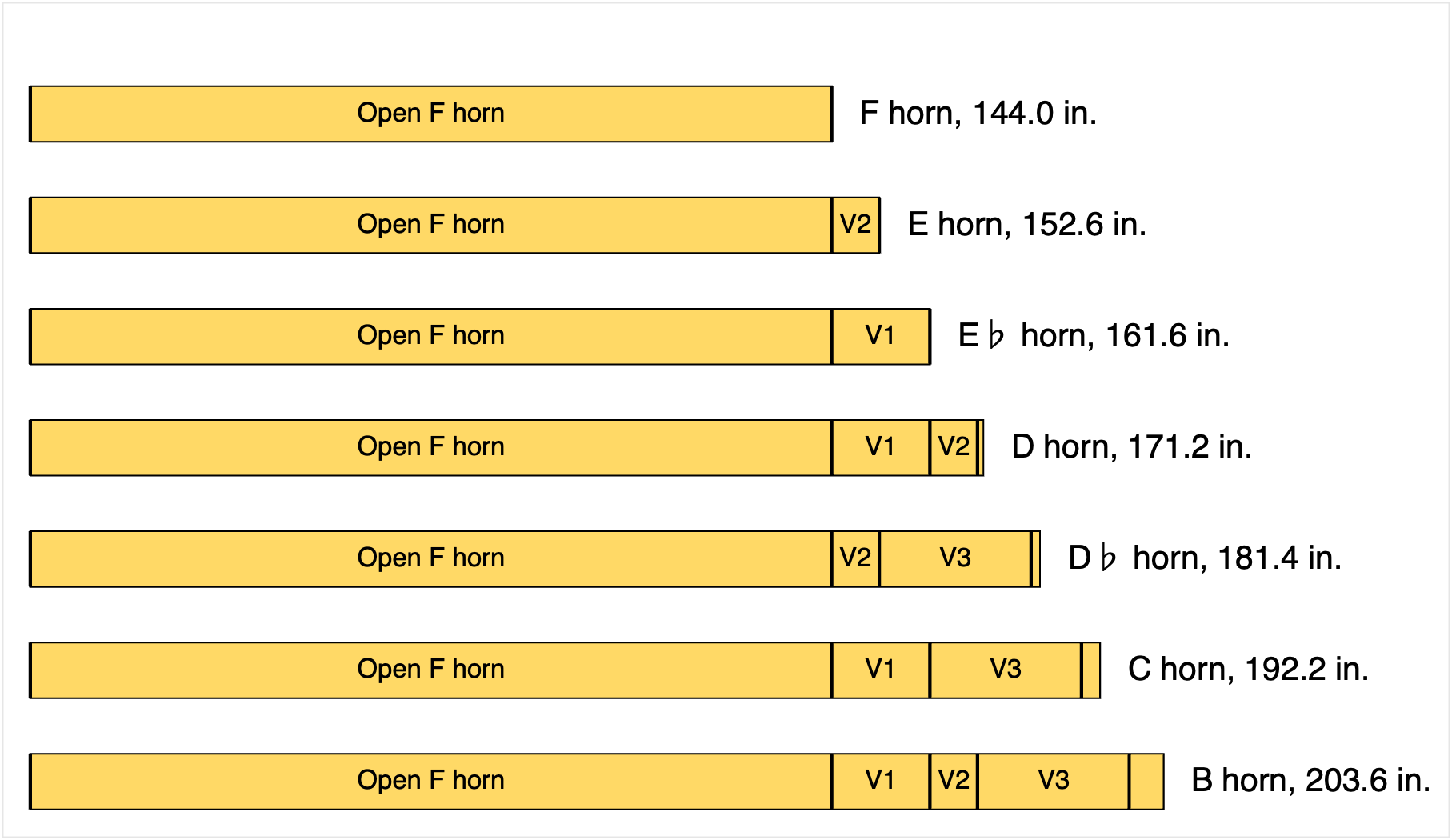You’ve probably heard or have experienced that the 12 fingering tends to be slightly sharp and that the 123 fingering tends to be extremely sharp. What about the 23 fingering? Or 13? How do they compare?
I’ve never seen the intonation for the different combinations compared precisely, and so I became curious about it, and I worked out the math details.
Let’s start with the F horn. I’ll assume that its effective length is 12 ft., or 144 in.

F horn, 144.0 in.
To lower the F horn pitch by a half step, making an E horn, the horn must be lengthened by approximately 5.95%, or 8.6 in. Valve slide 2 can be adjusted to exactly this length, as illustrated below. (Note: all of the calculations here assume an equal temperament scale.)

E horn, 152.6 in. Valve slide 2 adjusted to lower the F horn by exactly a half step.
To lower the E horn by a half step, making an E♭ horn, the E horn must be lengthened by 5.95%. The E♭ horn is 17.6 in. longer than the F horn. Valve slide 1 can be adjusted to exactly this length, as illustrated below.

E♭ horn, 161.6 in. Valve slide 1 adjusted to lower the F horn by exactly a whole step.
To lower the E♭ horn by a half step, making a D horn, the E♭ horn must be lengthened by 5.95%. (Are you starting to see the pattern?) Another few calculator button clicks show that the D horn length is 171.2 in., 27.2 in. longer than the F horn.
If valve slides 1 and 2 are tuned as above, then the total length of the F horn, slide 1, and slide 2 is 170.2 in., just a bit shorter than the D horn. The length discrepancy makes the F12 fingering 11 cents sharp compared to the D horn.
What is the reason for this length discrepancy? Think of it this way: Valve slide 2 is long enough to lower the F horn by a half step, but it is not quite long enough to lower the longer E♭ horn by a half step. The mathematical result is the same if you do it the other way around: valve slide 1 is long enough to lower the F horn by a full step, but it is not quite long enough to lower the longer E horn by a full step.

D horn, 171.2 in. The open F horn, valve slide 1, and valve slide 2 total only 170.2 in., which is 1.0 in. short of the D horn length. That makes the 12 fingering 11 cents sharp.
Now let’s look at the B horn. The length of the B horn is calculated by lengthening the F horn by 5.95% six times, resulting in a length of 203.6 in. How sharp in the F123 fingering compared to that? If valve slides 1, 2, and 3 are tuned to lower the F horn by a whole step, a half step, and three half steps, respectively, then the F123 fingering results in a horn that is 197.4 in. That’s 6.2 in. too short, and that makes the F123 fingering 54 cents sharp.

B horn, 203.6 in. The open F horn, valve slide 1, valve slide 2, and valve slide 3 total only 197.4 in., which is 6.2 in. short of the B horn length. That makes the 123 fingering 54 cents sharp.
Here are several horns shown together, with valve combinations, for comparison.

For comparison: F, E, E♭, D, D♭, C, and B horns.
Here are the intonation tendencies for all the combination fingerings.
| Fingering | Intonation Tendency |
|---|---|
| 12 | 11 cents sharp |
| 23 | 16 cents sharp |
| 13 | 30 cents sharp |
| 123 | 54 cents sharp |
When considering these numbers, it is important to keep in mind that horn playing in real life is different than the theoretical mathematical calculations above. First, a variety of additional factors affect pitch, including:
- embouchure
- aural cavity shape
- right hand position
- effects of changing horn diameter along the length
Second, horn players often use compromise tuning strategies, such as adjusting valve slides 1 and 2 to be just a bit long so that the 12 combination is closer in tune.
As long as one keeps these real-life factors in mind, though, the table above can be quite useful for understanding the intonation tendencies of the different fingering combinations.